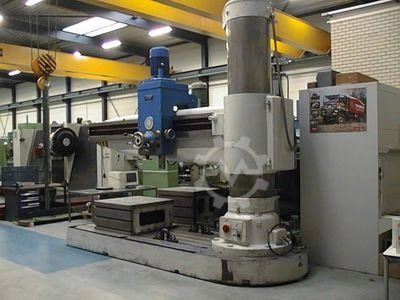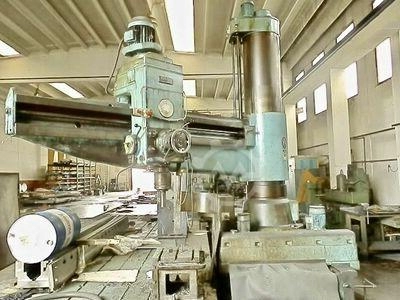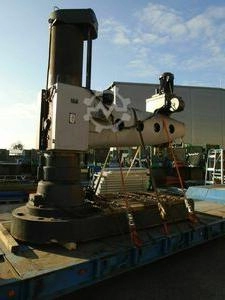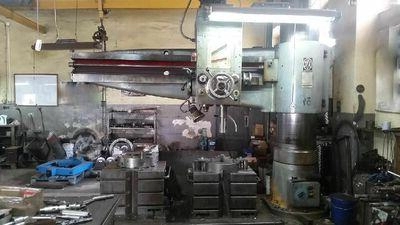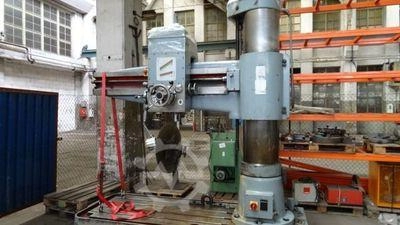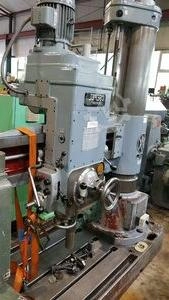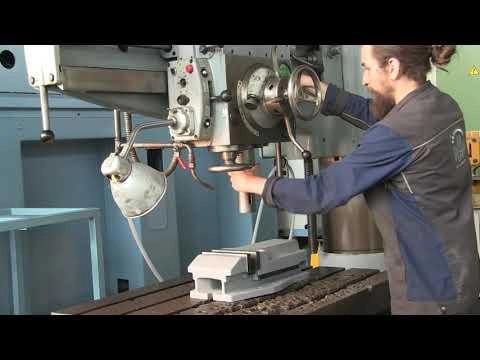CSEPEL-HOLDING PLC

General Information
| Full name: | CSEPEL-HOLDING PLC |
| Brand birthplace: | |
| Head office address: |
, () |
| www: | http://www.excel-csepel.hu |
| Info: |
SHORT REVIEW OF CSEPEL MACHINE TOOL FACTORY’S HISTORY
Machine tool building in Csepel had started in 1929 within the framework Csepel Works, earlier called Weiss Manfred Works. The company began its operation with the manufacture of radial drilling machines, centre lathes, knee-type milling machines as well as single-purpose machine tools (for special machining jobs). The first machine tools were built on the basis of a purchased licence, and in parallel, the development of self-devised and -designed machine tools was launched as well. From the early thirties on Csepel has been producing machine tools in series for the European markets which were then exported later on to many countries all over the world. As a result of this, up to the present, 40000 Csepel machine tools have been exported to more than 60 countries worldwide. Over the past decades a wide variety of machines for different purposes was designed that enabled to acquire a considerable experience in production of traditional technologies and also in a new, “know how”, technology application and development. A highly significant development step in Csepel’s machine-tool building was the nationalization of manufacturing NC machine tools in cooperation with Krupp and the Technische Hochschule, Aachen. Within the frame of this cooperation were built the first NC lathe and the first NC milling machine in the year of 1965. As further improvements, machining centres were also developed in 1970. Since high-precision machine tools were under consideration, a license from the British company Matrix was purchased for the thread-grinders machinesmanufacturing in parallel with the above developments, which were then followed by a self-developed gear generating grinder. To complement the company’s own production we introduced high-level technologies keeping up cooperation with well-known companies such as Lindner, Kaiser, Burghardt und Weber, SHW and Klingelnberg. From the end of World War II. until 1991 the Csepel Machine Tool Factory had been run in nationalized form, then it was privatized in March 1991 to become a German-Hungarian joint enterprise named Csepel F+K Machine Tool Factory Co. After a year and a half the company was redeemed in a tender by Excel Machine Tools Pte. Ltd. Singapore. Under Singapore leadership the company’s management changed over from manufacturing machining centres to smaller-size machine tools. Priority was given to the production of both machining centres and lathes in series. Meanwhile, the company succeeded in developing a complete family of lathes regarding both size and technological capacities. Nowadays, a new wave in production is manufacturing of special-purpose cutting-machines with partial involvement of the external developments. To complement the company’s production palette jobbing work was also resumed primarily with respect to machining parts for the vehicle industry as well as high-precision and casting-parts. The company had the norm ISO 9001 audited in April 1998. Our products are always delivered in compliance with this norm, with quality certificates and accuracy test reports attached. From the year 2001 on we have been in possession of a quality certificate acc. to ISO 14001 as well. TRENDS OF MACHINE-TOOL BUILDING DEVELOPMENT IN CSEPELFrom the year 2006 to 2007 the Csepel machine-tool factory could succeed in considerable increase of the sales turnover by 40% under the more favourable market conditions of the engineering industry at that time. Behind this fact lies a continuous technical development process pursued in the years past and compliance with current market demands in each case. A significant contribution to this development was that the company’s basic activities had changed in the past period, and new models compared to earlier ones were introduced, among them SLT630/1500BB MC or SLT800/2500 BB MC Y. In addition to the sales of so-called commercial machine-tools, i.e.: TOYODA, MITSUI SEIKI, we kept on carrying out the jobwork from earlier times, and our activities towards retrofitting/modernization of older machines have gained strength as well. The manufacture of CNC machines underwent a considerable change in comparisons with earlier small-series productions. Under market pressure, machine-tool building and trading in Hungary were forced to change as well. Also the unusually low-price and low-cost Asian machine-tools appeared in the Hungarian market, which quality significantly changed and improved compared to earlier estimations. These machines were knowingly designed so as to comply with the cutting job to be executed keeping in view simplicity and the preconditions for safe functioning. As a result of the large-lot and excessively over-simplified production the costs of these machines are extremely low with an ever increasing market share. To the circle of customers for these machines belong novice enterprises and small companies with very limited financial assets under the present circumstances given in Hungary. Another steadily growing and strengthening circle of customers purchases machines from well-known manufacturers of good repute thus often over-financing the necessary investment project. The third market segment of customers might be contractors who select the appropriate machine-tool with high technical characteristics for machining extremely complex parts in excellent quality. These machine-tools are generally oriented on the high-precision 3D surfaces in large dimensions machining, or on production of smaller-size but complex parts in large series. The functioning of these machines is characterized by extremely short cycle times. Under the above-described increasingly severe market conditions Excel Csepel Machine Tools Ltd. was forced to not only survive as a manufacturer, but also continue to develop and grow. This is why in the past years we turned our attention towards the marketing of more simple but high-quality machines at lower cost complying with Csepel’s design traditions, such as KAFO machining centres and FEMCO lathes. Another direction of our business activities is the marketing of Toyoda / Mitsui Seiki, Vertex machines satisfying extremely high technological requirements as well as flexible manufacturing systems (FMS) set up of these machines, resp. DEVELOPMENT WITH FULL KNOWLEDGE OF MARKET CONDITIONSThe past few years have proved the truth that the development projects marked out by Excel Csepel Machine Tools Ltd. are apt to ensure the company’s progress. Also the lathe SLT 800/2500 BBMCY was developed that was rewarded with the GRAND PRIZE FOR PRODUCTS and that was delivered, among other countries, to our customers in the US, Germany and Russia. The main driving power of development is taking into consideration the customers’ conceptions as far as reasonably possible. The course pursued in the past couple of years has shown that it is expedient to turn in the direction ofcustomer-oriented development and manufacture. The experience of the past few years indicates the necessity in orientation on the customer’s preferences during the product design and manufacturing. ALL IN 1 (TURNING – MILLING – 3D)Despite of the economic recession of the past recent years, Excel Csepel successfully completed the 2010th year owing to continuous technical improvements with respect to the market demands. Series-type production of machine tools in our factory was completely replaced by the development of custom-built machine-tools and special-purpose machines. This has been contributed to a number of other successfully completed main activities of the company. Reconstruction of machines, retrofittingThe demand to retrofit and purposefully convert older design high-duty machines of proved value increased in the past few years. As a result of this, beyond modernization, the dimensions of working areas had to undergo changes as well meaning that all main assemblies had to be remachined and reassembled requiring a considerable engineering input. Development of CNC roller-burnishing machines, roller-burnishingThe structural design of the lathe SLT-800/2500 renders possible that various options such as subspindle, second slide system, C- and Y-axis, possibly complemented with a B-axis, and spindle motor be implemented. Our railway axle roller-burnishing machine TR-800-2700 has been awarded with Prize for innovation in 2011. The technical devices and solutions to be applied in the field of CNC roller-burnishing are promising and give us hopes of future success in the world market. Milling head integrationAnother important step forward for Csepel Machine Tool Factory will be to implement new options in own making in order to ensure an even more complete cutting technology. The machine bed of the tried and tested lathe 630 will be exhibited at MACH-TECH 2011 in Budapest. This constitutes the base for the implementation of the so-called option to be fitted with a „B”-milling head and spindle motor. This comprises the further development of the mechanics, the electrics and the PLC. Simultaneously with the interpolation of 5 axes, practically 3D surfaces can be generated following the turning operations. By this means, some of the parts appearing in energetics industry can be produced more effectively and with higher accuracy. Workpiece manipulation, robotizationThe sale of the so-called flexible manufacturing systems (FMS) known from previous times was complemented with the elaboration of a full-scale manufacturing process. Based on our experiences gained in earlier years, our experts will continue to further improve robotization to comply with demands in mass production and with various suppliers’ requirements in motor-car industry. Full-scale machine attendance and operation is a more complex task in comparison with a workpiece manipulation in manufacturing systems. The next possible tendency of the further development based on customers’ requirements might be for us to return to earlier successfully functioned so-called travelling-column machine-tools production and to their modernization with respect to recent demands of the market. |
